
Friedrich Wilhelm August Fröbel or Froebel was a German pedagogue, a student of Johann Heinrich Pestalozzi, who laid the foundation for modern education based on the recognition that children have unique needs and capabilities. He created the concept of the kindergarten and coined the word, which soon entered the English language as well. He also developed the educational toys known as Froebel gifts.
Wilhelm Heinrich Ackermann was a German teacher.
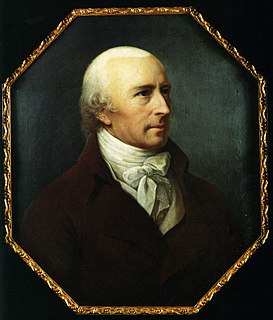
Joachim Heinrich Campe was a German writer, linguist, educator and publisher. He was a major representative of philanthropinism and the German Enlightenment.
Elisabeth Blochmann was a scholar of education, as well as of philosophy, and a pioneer in and researcher of women's education in Germany.
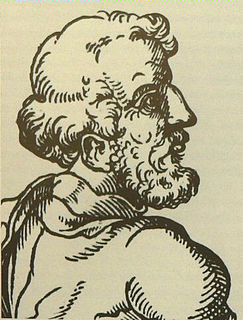
Jacob Micyllus, was a German Renaissance humanist and teacher, who conducted the city's Latin school in Frankfurt and held a chair at the University of Heidelberg, during times of great cultural stress in Germany.
Friedrich (von) Beust, German soldier, revolutionary and political activist and Swiss reform pedagogue, was the son of Prussian Major Karl Alexander von Beust. Beust was born in the Odenwald, in whose great forests, as a young man, he observed Nature in her large and small aspects and collected her creatures. He learned to ride a horse in the royal stables. In 1834, he became an ensign in the 17th Prussian regiment. Under the guidance of a captain, he drew maps in his free time. He entered the division school at Düsseldorf where he was especially interested in geography, which students of Carl Ritter were teaching. He continued his studies of cartography and also science, especially anatomy. In 1845, he was ordered to Fortress Minden, where he came to the conclusion he could not fit into Prussian military discipline, bitterly resigned in 1848, and became a political activist.

Johann-Wolfgang-von-Goethe-Gymnasium Chemnitz is a public secondary school in Chemnitz, Saxony, Germany, for grades 5–12. It is one of seven secondary schools operating in Chemnitz.

Johann Ernst Plamann was a German child educator. He based his work on the ideas of Johann Heinrich Pestalozzi and Friedrich Ludwig Jahn. Among his pupils was future German chancellor Otto von Bismarck.
The Burgschule or Oberrealschule auf der Burg was a secondary school (Oberrealschule) located originally in central Königsberg, Germany, and later in the suburban Amalienau quarter. It was the fourth oldest school in the city, behind Altstadt Gymnasium, Kneiphof Gymnasium, and Löbenicht Realgymnasium.

The Collegium Fridericianum was a prestigious gymnasium in Königsberg, Prussia. Alumni were known as Friderizianer.
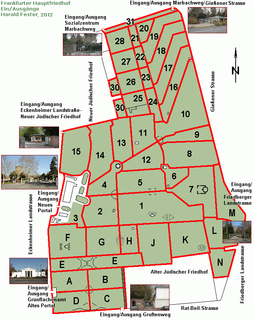
The Frankfurt Main Cemetery is the largest cemetery in Frankfurt am Main, Germany. It was opened in 1828. The cemetery is located directly adjacent to two Jewish cemeteries—the Old Jewish Cemetery and the New Jewish Cemetery, Frankfurt —and together they form one of the largest cemetery areas in Germany. The cemetery is noted for its many monumental graves, its garden architecture and as the site of the graves of many notable individuals.

The Meldorfer Gelehrtenschule (MGS) is a Highschool in Meldorf in the county Dithmarschen in Schleswig-Holstein. The school was founded as a Latin school in 1540. The School authority is the county Dithmarschen. As of 2014 there are 60 teachers and 886 students in 35 forms.

Henriette Goldschmidt (1825–1920) was a German Jewish feminist, pedagogist and social worker. She was one of the founders of the German Women's Association and worked to improve women's rights to access education and employment. As part of that effort, she founded the Society for Family Education and for People's Welfare and the first school offering higher education to women in Germany.
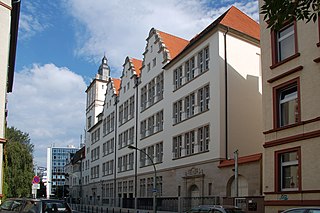
The Philanthropin is a Jewish elementary school and gymnasium in Frankfurt, Germany. It was founded in 1804 by Mayer Amschel Rothschild.
Rudolf Bülck was a German librarian.
Gerhard Menk was a German historian and archivist.
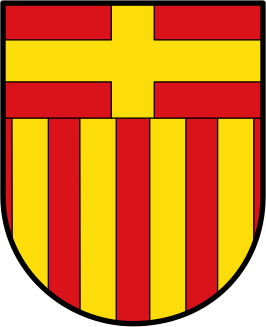
The Gymnasium Theodorianum is a grammar school situated in the historic centre of Paderborn, Germany. Succeeding in the tradition of the cathedral school founded in 799, it is among the ten oldest schools in the world. It continues in the ideals of Renaissance humanism, with Latin taught as the primary foreign language and Ancient Greek offered as an additional subject. The school has produced several leading German political, scientific, religious and military figures. It is known locally simply as the “Theo”.
Karl Friedrich Wilhelm Wander was a German pedagogue and Germanist. He published the largest existing collection of German-language proverbs.

The Ernestine Gymnasium is a humanistic and modern gymnasium in Gotha, Germany, the successor of the Illustrious Gymnasium, founded in 1524, which in 1853 was merged with the recently founded Real-Gymnasium Ernestinum, named in honour of Ernest I, Duke of Saxe-Coburg and Gotha. The merged school continued to be known as the Ernestinum. Until 1947, when it was closed, it was considered the oldest gymnasium in the German-speaking world. It was re-founded in 1991, shortly after German reunification.















